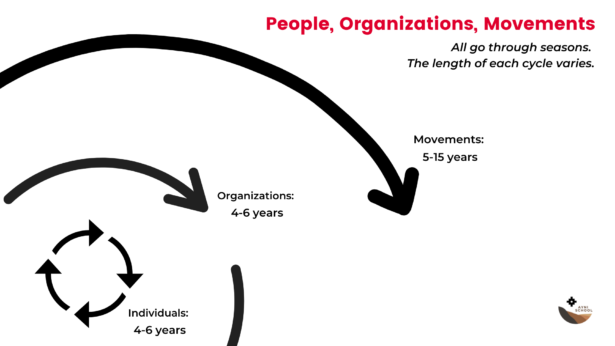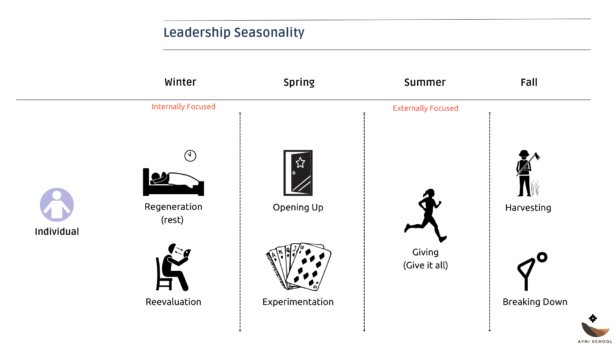Over the last two years, social movements, organizations and leaders around the world have been thrust into a period of tumult, transition and uncertainty. These moments of crisis in our personal lives and in society can force sudden changes in our capacity to respond. What happens when we are not able to offer leadership like we used to? Or inversely, what happens when we do have the energy and capacity to respond, but our efforts don’t yield the results that are expected?
Responsibility is the essence of leadership, and millions of community leaders who are working hard to resolve difficult, structural problems are uncomfortable when they feel like they need to respond to the moment, but are unable to. This can lead to burnout, or worse: leaders leaving the movement altogether, creating vacuums of leadership that don’t honor the cycles of our own development.
In my experience as a coach and trainer for many movement organizations, most of us are not prepared for those dilemmas in our leadership. Due to how often this issue arises, we at the Ayni Institute — a training institute working with movements and leaders to bring about a culture of reciprocity — believe that a new understanding of leadership is necessary to mediate some of these problems. Because of the lack of alternatives presented by both the state and the market, the pressure is on community leaders to find solutions. In these historical times it is necessary, perhaps more than ever, that we don’t just respond but that we respond strategically.
Cycles of leadership
One of the most important aspects of leadership that we must understand is that it is a resource, an energy, a capacity that goes through cycles — meaning that there are times that our leadership goes through ups and downs, times when we have more capacity to respond than others. Our capacity to understand and leverage them successfully relies on knowing which part of the cycle we are in.
Seasonality, or seasons, is a framework that many other spiritual and Indigenous traditions have used before that articulates the cyclical patterns of our own personal development and historical stages. We are interested in applying this perspective to our leadership, our organizations and the social movement we belong to. This will help us to conceptualize, appreciate and protect the ebbs and flows, the ups and the downs that occur throughout our time with this work — and it informs what we should be doing with intentionality, depending on the season we find ourselves in. This consciousness and groundedness in the seasons of our leadership can then help us be more strategic about how we are using our time and energy and direct our focus in the right direction.

Using the metaphor of seasonality as our guide, we find that there are four major seasons to our leadership cycles: winter, spring, summer and fall.
Winters are a time to be internally focused and are defined as periods of time for regeneration and re-evaluation. This is a time for processing the previous leadership cycles and developing insights and revelations about our own leadership (how we’ve tried to respond and how we want to respond). Winters oversee the process of recommitting to our own leadership cycles, and thus birth the new cycle. They are the space where the old is dying and the new is just beginning to emerge.
At the Ayni Institute, we believe that winters are an incredibly important part of the leadership cycle and that we must honor this time, just as we must honor and respect all the other seasons. The reality, even if we don’t want to admit it, is that we all go through winters and most of us go through unplanned ones: We get sick because of over exhaustion or people close to us experience difficult situations that create an impact on our lives as well. Many of us traverse these winters unintentionally and, most importantly, without support. This can lead to winters that never end, which can be dangerous and cause more damage to our leadership. In order to have successful winters, we need to strike a balance between resting enough to feel rejuvenated but also go through a reflection process to really know what kind of leader we need to be. If we strike this balance properly, we can receive the revelations and breakthroughs that can give birth to a spring.
Spring is about opening up, taking on new personal responsibilities and experimenting. In many ways, spring is about the start of a new cycle, the birth that comes out from the depths and darkness of winter. It is a time of excitement and openness, and recommitting to the task at hand. It is important to note that no season exists in isolation from the rest, meaning that there is an inextricable connection between the seasons in the leadership cycle. The degree of excitement and openness that one is able to feel as part of their spring depends on how deep and intentional the winter was. Ideally, spring is characterized by finding less resistance within ourselves to try new things or re-emerge, more willingness to take on responsibility again, take risks, meet new people and to approach things with curiosity, with a new sense of humility.
Just like every season, there are risks that come along with not having a successful spring; this can result in rushing to do too much in an effort to head into the summer too soon, causing one to feel overwhelmed by the newfound intensity. Moreover, by not having successful springs, we don’t take the time to experiment and take risks, to take advantage of the openness we are feeling, to ask ourselves different questions. If we don’t take the time necessary to have a good spring, we can miss out on innovation and new ways of thinking that our movements and organizations desperately need.
The summer is externally focused and is primarily about giving as much as we can to fulfill our different missions. It is a time of high energy, characterized by movement and intensity. Summers are the time for maximum activity, for a clear sense of purpose and direction that is full of determination. However, we need to find balance during the summer. This means that we must be moved by our energy, but not let it burn us out as we try to do too much. In order to have an understanding of this balance, we must understand that summers end and they can’t be prolonged, no matter how much we wish for them to be eternal. To have successful summers for our leadership requires us to dedicate the time to focus on a limited number of projects or areas. This necessitates saying no to things that could pull our focus and attention in different directions. We must view it as a marathon not a sprint, which means we must know when to bring consistent high energy in punctuated forms and at the right moments, and to rest in others.
Lastly there is fall, which is the season of harvesting the fruits from work during the summer and also starting to slow and break down certain elements to prepare for the winter. The fall is a time to reap the rewards of summer, it is the culmination of the advances and victories that may have been gained during the last season. Typically when leaders are in a fall season, they feel that their energy isn’t the same as it was during summer — this dip is of course natural and should be respected. You do not want to attempt to just push through, which can result in burnout. Just as summers should be understood as a marathon, we can think of fall as a type of relay race, meaning that we see the end of our role or work on particular projects and need to transition some of those roles or pass the baton to others, so to speak. The wisdom of fall is about knowing and understanding that cycles come to an end and about actually sustaining the fall to give ourselves time to prepare for winter because we know that it is around the corner.

As this cycle continues, and old cycles die while new ones are born, we also begin to notice that it is not just our leadership that goes through ebbs and flows — organizations and movements also go through the seasons. We begin to see all the different vehicles that we use to take responsibility move in this cyclical way.
In our training sessions, we see that experienced leaders have already been through multiple leadership cycles. They can see that they have been in winters many times before in their leadership journey. That is why it is important to take time to map and reflect on our current and previous cycles of leadership. Some questions that we have found to be helpful are: What season are you really in? What was your last season about? What do you need to do to have a healthy season?
The eternal summer and the pain of misalignment
All that we have been sharing up to now feels like common sense, leadership is a resource that goes through ebbs and flows that require space, time and intention in order to grow and develop. Yet, why is it so difficult for leaders, organizations and movements to move at the rhythm of their seasons?
We believe this is due to two factors: the first is our dominant culture of over accumulation. The logic of overproduction makes us believe that we should constantly be pushing all the boundaries. This assumes that we as a human species operate outside the laws of nature — that there are no cycles, only arrows that keep moving up from progress to more progress. This belief system and infrastructure is part of the dominant culture that envelops us. It tells us that we must always be in summer, that we must do more, be more, never stop, that we must live simply in an eternal summer that produces without end.
Second, many of us live disconnected from Mother Earth, from the seasonality of life. Because of the nature of our global capitalist economy, most of us live in cities marked by a deep disconnection with our environment. This is reflected not only spatially but in our consumption patterns, our reliance on the market to meet our needs, and the commodities we consume year round, independent of their own natural cycles (this can be seen with food in particular). Capitalism has created a system of consumption that invisiblizes where and when things come from and this dynamic disconnects us from the wisdom of cycles.
Neglecting and not being aware of our seasons is the formula for burnout.
At the same time, in order to sustain the ideological belief of the eternal summer, we’ve also developed something we call winterphobia, a situation in which many of us are afraid of going within, of taking time to rest, reflect and change. Winters done with intention force us to be vulnerable — a practice that is not usually welcomed or received within the confines of our dominant culture. We fight against the winter, we feel ashamed about it, but we forget that winters are actually as critical as those times where new leaders, new projects, new revolutions are born.
If you feel like you’ve been trapped in the eternal summer, you are not alone. We all have been there. We can all feel the pain of misalignment when we are constantly forced to be in a season we are not in and to pretend to be. Neglecting and not being aware of our seasons is the formula for burnout. In other words, when an organization doesn’t value people’s cycles and places — by putting people who are in much needed winters in positions that should be reserved for those in summer — burnout is an inevitability.
In his book “The Burnout Society,” Byung-Chul Han brilliantly elucidates this point. “Depression — which often culminates in burnout — follows from overexcited, overdriven, excessive self-reference that has assumed destructive traits,” he writes. “The… subject grinds itself down, so to speak. It is tired, exhausted by itself, and at war with itself. Entirely incapable of stepping outward, of standing outside itself, of relying on the Other, on the world, it locks its jaws on itself; paradoxically, this leads the self to hollow and empty out. It wears itself out in a rat race it runs against itself.”
We believe that in order for us to have sustainable and growing leadership we must be critically aware of the culture of the eternal summer and regain our relationship to Mother Earth. This is the wisdom we need, as Pablo Solon, a Bolivian social and environmental activist says, “Time and space are not linear but cyclical. The linear notions of growth and progress are not compatible with that vision. Time advances in the form of a spiral. The future is connected with the past. In any advance, there is a return and any return is an advance. Hence, as the Aymara say, to walk forward we have to have our eyes on the past.”
While we cannot change our current world dominant culture overnight, we believe that many of us have the agency in our own leadership and organizations to bring forth a new paradigm. The most important message we want to convey is that we must understand and protect the season we are in. Once we do that, we will learn the wisdom of that particular season and be able to start on a healthy cycle.
The power of seasonality
When we see leaders that have done social movement work for decades, we can see how they share a common belief around leadership that relates to the capacity to think strategically, to know when is the right time to do something. Doing the right thing at the right time is strategic capacity. When leaders are able to do this, the results, or the rewards, are massive. “Strategic thinking is reflexive and imaginative, based on ways leaders learn to reflect on the past, attend to the present, and anticipate the future,” explained Marshall Ganz, a community organizing scholar and former director of organizing for the United Farm Workers.

Support Us
Waging Nonviolence depends on reader support. Become a sustaining monthly donor today!
DonatePart of what blocks our strategic capacity is the inability to discern and attune to the cycles of our own leadership, and those of the organizations and movements we are embedded in. In order to build this strategic capacity, as a muscle, as part of the craft of organizing and to build a more renewable type of leadership, understanding which season we are in is of utmost importance.
Each season plays an integral and necessary role in our leadership cycle. It is our hope that this framework, this metaphor, can help give language to experiences that we know leaders face as they develop and traverse through many cycles in social change work. We believe that understanding our season, and appreciating its gifts, can help us move more intentionally, and thus, more strategically through the uncertain terrain and waters that surround us. We know that because of all the compounding crises we face at every level — whether it be personal, local, regional or global — we need to invest in a leadership model that is sustainable and renewable. By doing so, we can have millions of leaders working to bring about a new world, one that is rooted in connection to each other and to Mother Earth.
We are living in times of increasing uncertainty and crisis, when the future of our planet and of our relations to each other are at risk. How we respond in this moment can define our next cycle, and with the wisdom of our ancestors to guide us, we can forge a new tradition of resilient and strategic leaders.

At the beginning of January, my organisation wrote me a letter asking me to withdraw completely, not to participate in anything. At first I felt attacked, but I chose to sit quietly and reach out for help and advice. I knew I wasn’t going to say “yes” to the letter: my skills are really useful to the organisation. I have been in winter mode, reluctantly at first, and feeling alone and unsupported, but now, into the fourth week, amazing realisations and new win-win stratgeies are arising! I woke up this morning feeling renewed and ready to reawaken (“spring” is coming!) and the first thing I did was to read this article, which popped into my in-box. Thank you so much! These ideas will really consolidate the learning that has come to me during my “winter” experience.
Thank you so much for printing this article at this time. After receiving an award for my work just before Covid 19 and feeling unworthy of this award, I felt driven to be an example to others and unable to do this. Personally, I was exhausted, and due to aging and accompanying medical problems and emotionally I felt used up. This has resulted in burnout and depression, but I just kept trying to plow on It has really worried me and now has gone on for several years. Your article has led me to contemplate allowing myself at least some grace while I take the time to allow myself to heal. God willing, it may help.
a timely reminder of our connections to the seasons and to the earth. Down time and reflective practice, restoring our energies brings new ideas and freshness to our work . Thank you
Thank you for this article! I’ve bookmarked it and plan to review it at key milestones of my current campaign — education funding ballot initiative in Idaho (ReclaimIdaho.org).